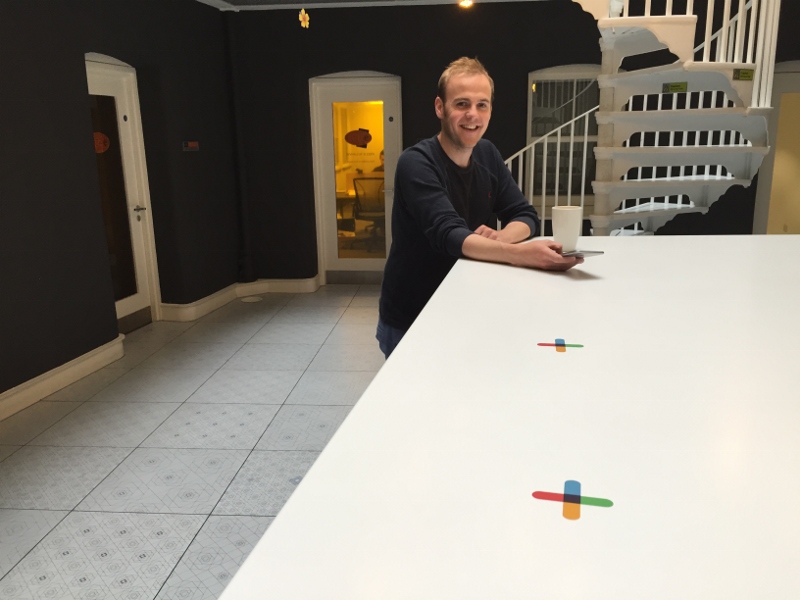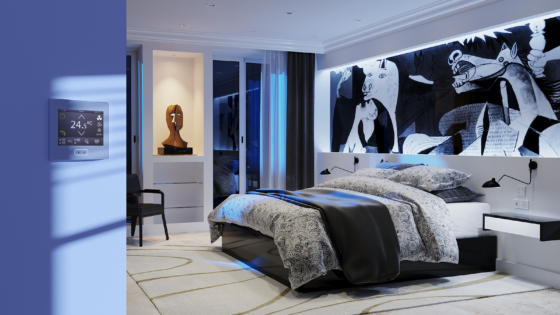As part of this month’s spotlight on technology, Hotel Designs’ editor Hamish Kilburn sat down with the co-founder of Chargifi, Dan Bladen, to find out whether or not there’s a need for wireless technology in the modern hotel…
Creating a modern hotel with all the right technology is, at times, like walking on a tightrope. Too much and you will alienate guests into never checking back in. On the other hand, too little – such as no charging units next to the bed, which is a personal bugbear – and you’ll get lost in the crowd of hotels with a reputation of not listening to modern consumer demands. To make sense of what’s what, I sat down with the co-founder of Chargifi, who travelled the world before finding a solution.
Hamish Kilburn: At what point does technology go too far in hotel design?
Dan Bladen: The chief aim of any innovation is to provide a better experience and – with the primary focus being a seamless guest service – this is even more important for the hospitality industry. The personalisation that technology can provide is key to achieving the best possible hotel stay because every guest will have a different gauge of what constitutes ‘good service’.
However, like with every positive innovation, there is a small risk of not recognising the point whereby guests feel that data collection or video interaction is intruding upon their privacy. Hoteliers need to strike a good balance between being ‘thoughtful’ with the personalised technology features they provide, versus overloading a guest with complicated devices. That is one of the reasons why simplicity was very important to us when we were creating the Chargifi platform – we wanted users to be able to choose when they charge, to be able to power up in a straightforward motion, and to glean data to inform a personalised service without constantly disturbing a brand’s key customer base.

Dan Bladen using Chargifi
HK: What was your travelling experience in 2012 like?
DB: The idea for the business came about when my wife and I were travelling the world a few years ago. We realised that much of our movement was dependent on where we could get a decent Wi-Fi connection, yet we still constantly struggled to keep our devices charged.
When we got back, my friend, founder and non-executive director Charlie Cannell and I got together to address the issue. We talked about how we might be able to give venues like coffee shops, bars, hotels and airports the ability to offer customers a wireless charging service while gaining valuable insight into their customer’s behaviour.
HK: What makes you think that by 2027 kids will not know what wire-dependent charging is?
DB: The launch of iPhone 8 and X was the tipping point for wireless technology – when Apple does something, everyone sits up and takes notice. It put wireless power on the map and now we are seeing wireless laptops (such as Dell’s latest designs), drones and electric vehicle charging pads launching on a monthly, if not weekly, basis. The result is that wireless tech is normalising.
Wireless is going on the same journey as Wi-Fi, and wired chargers will soon seem as outdated as using an Ethernet cable to log onto the internet. This normalisation is not only supported from within the wireless charging industry, but also by environmental considerations. The UK government has been rethinking how battery technology will work in the future for over a year now. Last week, Sir Richard Branson called for plans to ban the sale of new petrol and diesel vehicles from 2040 to be brought forward to 2025, pushing wider spread EV adoption. Escalations such as these will require wireless technology on demand or we will be looking at a major power jam… and necessity is the mother of invention, after all.
HK: What are the main benefits of wireless charging technology?
DB: Aside from the obvious benefits of no fuss, no cables creates a seamless charging experience.
With a smart wireless charging solution, brands can use data to get to know the customer better. Hospitality venues will be able to access customer data and real-time insights that are both relevant and don’t require lengthy and invasive guest interaction to procure. Hotels and restaurants can use this data to stay informed and as a competitive advantage. The Chargifi App, for instance, allows you to require a user to install your app to gain access to wirelessly charge their device – by gating this high-demand amenity hoteliers can encourage guests to download their mobile app. Basically, having a piece of technology that drives engagement 24/7, and not having to worry about it.
Another advantage is the increased dwell time and revenue as you are capturing a more receptive audience – interaction is guaranteed when you are servicing a need. Not only this but footfall or dwell time increase due to wireless power has the potential to create a point of difference. With eCommerce on the rise, encouraging people to come in, sit down and spend money is more important than ever – particularly for the hospitality industry that is so reliant on customers physically being on site. In our most recent deployment in a global hotel brand’s bar area – we saw a 64% increase in revenue, with the average charging session lasting 50 minutes.
This combined with the ability to provide a personalised service on a micro level means hotels can use wireless charging as a trigger – which in turn supplies hyper-local data on the target customer base to become a convergence point for smart functionality like location services and cloud-based data.

Image credit: Chargifi
HK: Should wireless charging be limited to certain areas of hotels?
DB: The short answer is: no. If you want to provide a convenient service then that service should be wherever the need could potentially arise. Meaning, in this case, that access to a convenient power source should be located anywhere guests will have their smartphone with them – be that the guest’s room, or in the lobby, bar, meeting rooms. Recent surveys have shown that many people browse through their social media feeds until their eyes get too tired and they eventually turn in for the night – it is also the first thing they do in the morning. And yet battery anxiety is still a real issue. Today, it would seem preposterous to deploy WiFi in just a couple of spaces within a hotel, and yet this was its origins. We will get to the stage where it will seem just as absurd to limit cordless power to a handful of locations.
HK: Can you explain for me what you think the hotel room of 2027 will look like?
DB: Hilton Worldwide’s view of the future is that guests will want to control their room’s thermostat, television, and other amenities via their mobile phones.
This future hotel room of 2027 would be one that has mastered a connected and intuitive guest experience, and where the guest’s own smartphone is key to “powering” that connected technology. This might translate to a beacon-enabled check in, food ordering before you arrive at the restaurant, re-routing orders to arrive wherever it is that you are at the time your food is ready to eat, PowerPoint uploads on the conference screen that you have set up from home: basically your smartphone will be a portable concierge. We are nearly there with these innovations. None of which can happen when you run out of battery due to usage of all this innovation.
HK: Why is wireless charging appropriate in all hotels, regardless of style and period?
The practical advantage is the reduction in cables and all the inconvenience associated with them. Wireless charging spots are flexible and can be curated to any surroundings and styles – for instance Chargifi comes in two forms to fit with the furniture and requirements of individual hotel design. Surface units require a simple hole to be made in the furniture, and then sit slightly risen from the surface top, with a subsurface that fits just below the furniture. There is no real limitation to the materials of that furniture or design of the room it is sitting in.
HK: We know that hotel guests’ demands are constantly changing, in line with technology. How do you predict them changing in the next 20 years?
DB: We have three main channels of thought surrounding this change…
1) People will expect to be connected / have access to power whenever, wherever.
2) Spaces are going to be more collaborative and experiential
3) The concept of home/ hotel will begin to merge and expectations of a personalised convenient experience will be there across the board
Chargifi is already deployed in over 21 countries, and you can check out some of latest developments on Twitter. The next few years are going to be about seeing that number grow across the globe.
Main image credit: Chargifi





